
Charles Emmanuel Marie Mangin was a French general during World War I.

Alfred Amédée Dodds was the commander of French forces in Senegal from 1890, commander of French forces in the second expeditionary force to suppress the Boxer Rebellion, and commander of French forces during the First and Second Franco-Dahomean War.
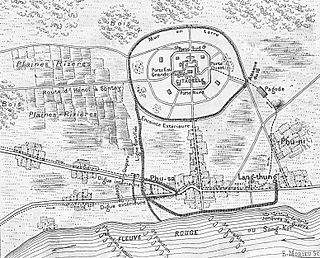
The Sơn Tây campaign was a campaign fought by the French to capture the strategically important city of Sơn Tây in Tonkin from Liu Yongfu's Black Flag Army and allied contingents of Vietnamese and Chinese troops. The campaign was one of several clashes between the Tonkin Expeditionary Corps and the Black Flag Army during the Tonkin campaign (1883–1886), and took place during the period of undeclared hostilities that preceded the Sino-French War.

The Tonkin Expeditionary Corps was a French military command based in northern Vietnam (Tonkin) from June 1883 to April 1886. The expeditionary corps fought the Tonkin Campaign (1883–86) taking part in campaigns against the Black Flag Army and the Chinese Yunnan and Guangxi Armies during the Sino-French War and the period of undeclared hostilities that preceded it, and in important operations against Vietnamese guerrilla bands during the subsequent 'Pacification of Tonkin'.
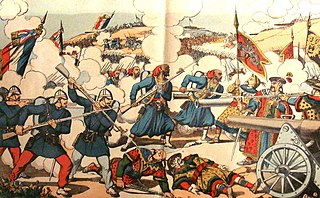
The Lạng Sơn campaign was a major French offensive in Tonkin during the Sino-French War. The Tonkin Expeditionary Corps, under the command of General Louis Brière de l'Isle, defeated the Chinese Guangxi Army and captured the strategically important town of Lạng Sơn in a ten-day campaign mounted under formidable logistical constraints.
The Tonkin Flotilla of 1883 was a flotilla of French Imperial gunboats and despatch vessels used to enforce French Colonial rule on the waterways of Tonkin. It was organized during an episode of the French Conquest of Vietnam known as the Tonkin campaign (1883–1886), in which the French were to fight against—variously—the Vietnamese, Liu Yongfu's Black Flag Army and the Chinese Guangxi and Yunnan armies with the objective of occupying Tonkin and entrenching a French protectorate there.

François Oscar de Négrier, known as Oscar de Négrier, was a French general of the Third Republic, winning fame in Algeria in the Sud-Oranais campaign (1881) and in Tonkin during the Sino-French War.

The Tonkin campaign was an armed conflict fought between June 1883 and April 1886 by the French against, variously, the Vietnamese, Liu Yongfu's Black Flag Army and the Chinese Guangxi and Yunnan armies to occupy Tonkin and entrench a French protectorate there. The campaign, complicated in August 1884 by the outbreak of the Sino-French War and in July 1885 by the Cần Vương nationalist uprising in Annam, which required the diversion of large numbers of French troops, was conducted by the Tonkin Expeditionary Corps, supported by the gunboats of the Tonkin Flotilla. The campaign officially ended in April 1886, when the expeditionary corps was reduced in size to a division of occupation, but Tonkin was not effectively pacified until 1896.
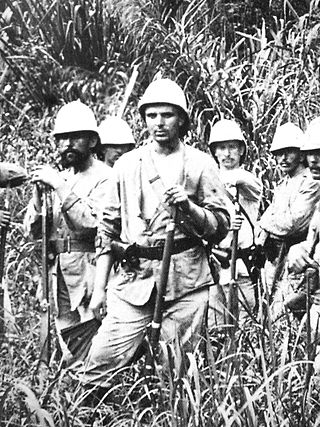
The Pacification of Tonkin (1886–1896) was a slow and ultimately successful military and political campaign undertaken by the French colonial empire in the northern portion of Tonkin to reestablish order in the wake of the Tonkin campaign (1883 1886), to entrench a French protectorate in Tonkin, and to suppress a Vietnamese anti-French uprising.

The 2nd Marine Infantry Regiment is an infantry regiment of the Troupes de marine in the French Army, the only regiment to bear 16 battle honours inscriptions of the regimental colors. The regiment is one of the "quatre vieux" regiments of the Troupes de marine, with the 1st Marine Infantry Regiment 1er RIMa, the 3rd Marine Infantry Regiment 3e RIMa and the 4th Marine Infantry Regiment 4e RIMa ; also, alongside the 1st Marine Artillery Regiment 1er RAMa as well as the 2nd Marine Artillery Regiment 2e RAMa which formed the Blue Division.

Antoine Virgile Schneider was a French general and politician. He was Minister of War under the July Monarchy in the second government of Jean de Dieu Soult from 12 May 1839 to 1 March 1840.
Lieutenant-Colonel René Philippe Laverdure was a French army officer. He enlisted in the army as a private soldier in 1880 and saw active service with the 1st Marine Infantry Regiment and the Regiment de Tirailleurs Annamites in the Tonkin Campaign in modern Vietnam. He was promoted through the army's non-commissioned ranks and became an adjutant in 1884. A display of bravery on the battlefield won him a commission later that year.
Henri Alexis Joseph Vanwaetermeulen was a French general of the First World War who began his career as a private soldier. Enlisting into a line regiment in 1883 Vanwaetermeulen was promoted to sergeant major within two years and received his commission within five. He transferred to the Troupes de marine and saw service in several French colonies. In Tonkin Vanwaetermeulen was mentioned in dispatches for leading assaults on two forts and received the Colonial Medal. He saw further service in Madagascar, Senegal and Mauritania, much of it under the command of Joseph Gallieni, and by the outbreak of the First World War was a lieutenant-colonel.
Léon Amédée François Raffenel was a general of the French army. Enlisting into the army in 1875 he quickly rose through the ranks and was accepted into the Ecole Spéciale Militaire de Saint-Cyr in 1876. He saw extensive active service with the French colonial army in the Pacification of Tonkin between 1887 and 1892, being cited in the order of the day for his adept command of columns of native infantry. Having married in 1893 Raffenel requested transfer to the France-based metropolitan army in 1894. This unusual move was complicated by the separate organisation of the two French armies but was approved by presidential decree. Raffenel spent 16 years in the metropolitan army and commanded the 27th Infantry Regiment and the elite 82nd Light Infantry Brigade. He was promoted to général de brigade in 1911 and received command of the 3rd Colonial Infantry Division, one of the finest divisions of the French Army. He fought with this unit at the Battle of Rossignol on 22 August 1914 and was killed in action in what was a heavy defeat for the French troops.

Charles Rondony was a French general. Joining the metropolitan army as a private soldier in 1875 he rapidly rose through the ranks and was commissioned into the Troupes de marine in 1880. Serving in the Tonkin War in command of indigenous troops he was wounded during an attack on a fort, he was posted briefly to Senegal before returning to Tonkin in 1890. During the Pacification of Tonkin Rondony distinguished himself, being wounded twice in action, being cited in the order of the day, receiving the Tonkin and Colonial Medals and being appointed a commander of the Order of the Dragon of Annam. Returning to France in 1897 he was promoted to lieutenant-colonel and saw service in the Boxer Rebellion of 1900–01. Furthers postings in Tonkin and Madagascar followed before Rondony was promoted to général de brigade in France. Holding command of the 3rd Colonial Brigade upon the start of the First World War he led it in defeat at the Battle of Rossignol on 22 August 1914. Rondony and his divisional commander, Léon Amédée François Raffenel, were killed in action, the first French generals to die during the war.
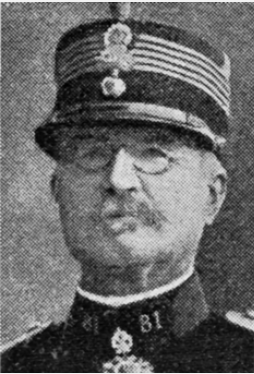
Paul Emile Diou was a French general. Diou entered the army in 1873 and spent much of his early career superintending the training of army personnel. He saw extended service in Tunisia with the Army of Africa and also in the Far East. Diou was praised for his work in Morocco in 1908 and was subsequently appointed to brigade command. In the opening stages of the First World War he led his brigade in an attack on German positions and was mortally wounded.
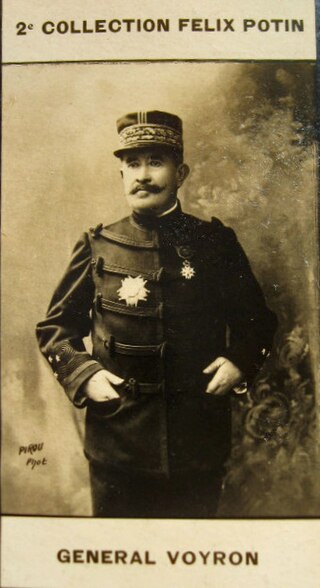
Émile Jean François Régis Voyron was a 19th-century French general most notable for his service in the Franco-Prussian War and the Boxer Rebellion.
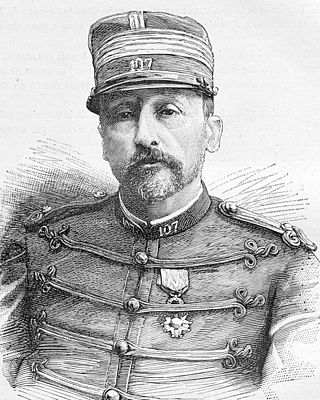
Alphonse Jules Alexandre Dugenne (1841–1887) was a French colonel who led the Bắc Lệ ambush during the Tonkin campaign as part of the French effort to capture the territory that would become French Indochina. He was later decorated as Officer and Knight of the Legion of Honour.
René Auguste Émile Boutegourd (1858-1932) was a French brigadier general of World War I. He commanded the 51st Reserve Division throughout the war, notably leading the division at the First Battle of the Marne.
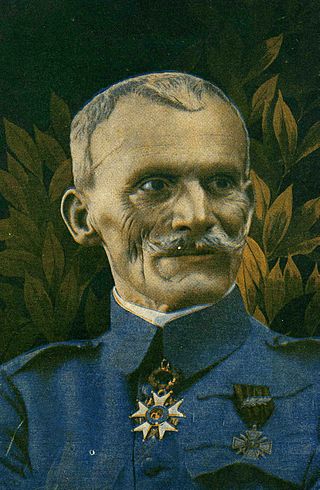
Jean-Marie Joseph Armand Brulard (1856-1923) was a French Général de Division who participated in World War I. He spent an extensive part of his military career in Tunisia, Tonkin, Algeria, Madagascar, Morocco and the Dardanelles. He was once told by a superior that: "Son nom est un drapeau.". He was also known for being a recipient of the Grand Cross of the Legion of Honour.















